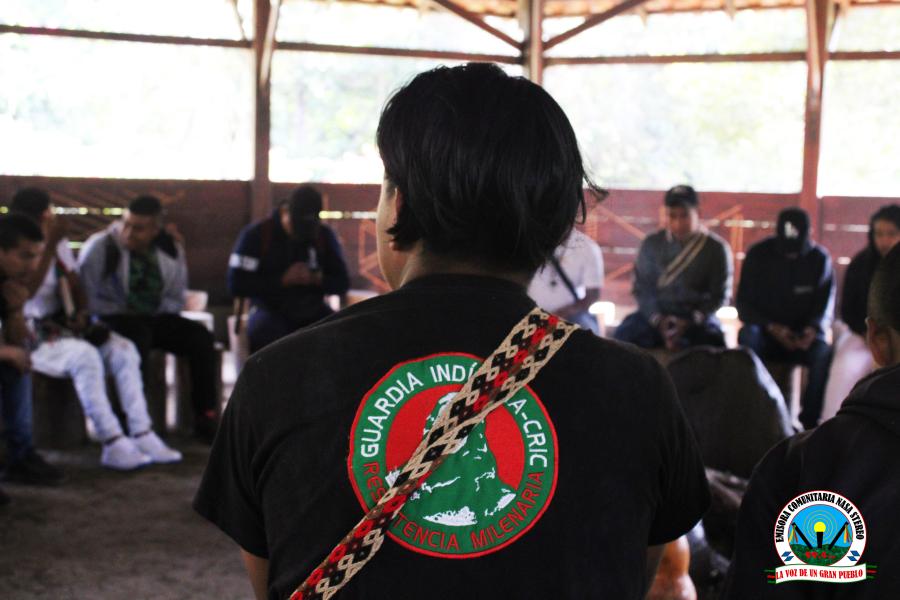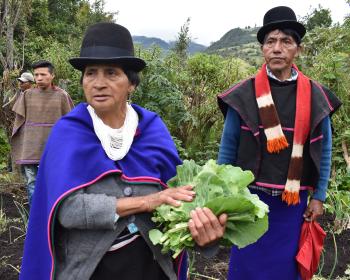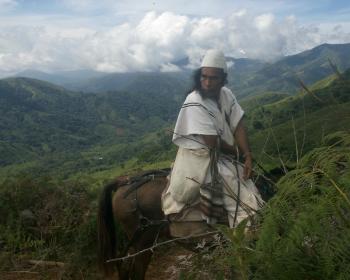“It was very beautiful. There was plenty of food; the people here hardly ever got sick because everything was clean; there was a beautiful pond, unpolluted. This was what life used to be like here. It was very safe; you could go wherever you wanted, at any hour of the day or night…
“My house, mine and my husband’s, was a memory that was very dear to us… We had two bedrooms, a dining room. That was the dining room, a bedroom there, and there another bedroom. And the bathroom there. With the toilet there..!
“Lemon trees, squash, that’s how we supported ourselves. We supported ourselves with 300 or 400 lemons from that lemon tree there. We bought rice, lard . . . that helped us out. And over there was a grove of plantains.We had guava trees, plantains, a grapefruit tree, tangerines.
“Look how it’s all destroyed. They destroyed everything.”
This was how Aura Pérez, a resident of the village of Tabaco in Colombia’s remote Guajira peninsula, described her home before it and the rest of the village was razed by Cerrejón Zona Norte, the largest open-pit coal mine in the world. Cerrejón is a huge, gaping gash 30 miles long by 5 miles wide in the hot, dry landscape. On August 9, 2001, mine employees, supported by armed security guards and the national police and army, used bulldozers to level Tabaco. Four years later, Aura Pérez was dead.
“She died of impotence,” says her brother José Julio, who also was displaced when Tabaco was destroyed. “We lost our homes, we lost our land, we lost our community, we lost our livelihoods, we lost everything. When she became sick there was no way to get the medicine she needed.” Aura Pérez was one of 14 people who died after the villagers were displaced.
“We were thrown off our lands, we saw the authorities bulldoze our homes,” added Pedro Borja, another member of the community. “Here in Colombia the powers that be break their promises. For us there is no law. They have ruined our plans to study, our health. Cerrejón is one of the richest companies in Colombia, so why are we paying for this?”
This land has been inhabited for hundreds of years by the indigenous Wayuu people and also by mestizo peasants and Afro-Colombians—escaped slaves who set up communities next to indigenous peoples and adopted much of their culture. For generations, these communities have traded products and customs, creating a unique Guajira culture while maintaining distinct indigenous and Afro-Colombian communities.
The Wayuu are the largest indigenous group in Colombia. In the northern part of the Guajira peninsula, where it is too dry for farming, they raise goats and cows; to the south, they also farm. Hunting and fishing contribute to their sustenance, as does temporary and migrant labor, in Colombia and across the border in Venezuela. They are organized in large matrilineal clans, which maintain residences in different parts of the peninsula. They’re known for their woven hammocks and shoulder-bags (mochilas), which they make for personal use as well as for sale in the small tourist market along the coast.
Before it was destroyed, Tabaco was the largest village in the area, with a population of about 700. It was the municipal center upon which the smaller villages of Tamaquito, Roche, Chancleta, and Patilla depended: It had a school, a health center, a Telecom (state telecommunications company) office, running water, electricity, a park, a church, and a cemetery. But Tabaco sat on top of coal, which sealed its fate—a fate determined long before the bulldozers showed up. In the early 1990s company representatives began to approach residents, asking them to sell their land. “They told us that we could continue to farm, that they didn’t plan to use the land,” José Julio explained. “They said they wanted the titles just for security’s sake. A lot of people sold, because it seemed like a gift. Even though the price they paid was laughably low, it was like getting something for nothing.”
But instead of improving, life began to get more difficult in Tabaco. Unoccupied lands around the village, which had been used for hunting, were disappearing into the mine. Ranches and farms owned by larger landowners, where Tabaco residents had worked, were sold off to the company. The Ranchería River, which had served many of the communities as a source of water and fishing, was turning brown, murky, and foul with run-off from the mining activities. As sources of work and livelihood withered away, people began to cave in to the company’s increasingly coercive offers; they began to sell their houses and leave. The company warned residents that the value of their properties was fading fast: Sell now, or be sorry later. By August 9, 2001, the community had shrunk significantly. It’s a process now playing itself out again in some of the smaller indigenous and Afro-Colombian villages threatened by the mine’s inexorable expansion.
Today, about 100 former residents of Tabaco remain organized as Tabaco in Resistance. They’ve lost their homes and mostly live with relatives or in inadequate quarters in the nearby town of Albania. They won’t settle with the company because they won’t give in on their key demand: They want to be recognized as a community. They are asking for collective negotiations, collective relocation, and reparations for the years, the families, and the community that they have lost.
“I have suffered in the flesh everything that has happened,” said María Isabel Ríos, one of the members of Tabaco in Resistance in Albania. “They kicked us out of our homes, they mocked us and violated our rights. My daughter Santiaga has nightmares, she suffers from nerves, eats her nails and hair. In her nightmares the police are destroying our houses. She is always asking whether they are coming back to attack us. Now we don’t have enough food. We feel weak and alone. In Tabaco we had a house with three or four rooms, now we are all in two rooms. We have gone through nine years of this process. We only have electricity in spurts; sometimes we only have water for one hour a day. Our children have endless colds and skin diseases that the hospital can’t cure. Our eyes burn, we have chest pains and headaches. This isn’t human: they have left us in ruins.”
The smaller communities of Tamaquito, Roche, Chancleta, and Patilla are barely clinging to life as the mine encroaches. Wilmer Palmesano, the president of the Community Council of Chancleta, explained what happened to his community as it lost access to its former means of livelihood: “In the 1980s the company started buying up land, and today we have nowhere left to sow crops, nowhere to put our animals. We’ve gone from being a productive community to a community of paupers. If you look around you can see the majority of houses are empty because people have abandoned them. We are drinking contaminated water, and they would not respond. Finally, after endless pressure, they started sending a water truck to supply us. Even though we are pretty much all unemployed, we have been raised on this land, and we don’t steal. With no land and no place to put our animals, we are talking about a radius of about 80 meters around this place, and beyond that the mine has bought up all the land and put their security guards on it—guards who patrol on horseback.”
“We want relocation, we want to stay together as a community,” Palmesano went on, reiterating a point made by many people during our visit there. The communities have lived and worked collectively for hundreds of years and are worth much more than the plots of land that their huts stand on. What is needed, we were told again and again, is a place, and the resources, to reweave the social fabric that has been rent to shreds by the coming of the mine.
“There’s been talk of coal for the world and progress for Colombia,” said Eder Arregoces Pinto, a member of the Chancleta Community Council, echoing the Cerrejón company’s slogan. “If that is so, we ask, to what country do the towns of Chancleta, Roche, and Tabaco belong? There are droves of young people just wandering around because there is no school, there is no work. What a paradox: We are surrounded by the world’s largest coal mine, and we don’t have enough to eat! Most of the families here can only eat one meal a day, all because we don’t have land. There is outrageous exploitation that fails to see that there are human beings living here, there are black and indigenous communities. The environmental situation is worse than critical. The government pursues those who plant bombs and kill people. But what about a company that is slowly killing people off with contamination? Is that not terrorist?”
The big picture
The labor, and the land, of indigenous and African-origin people of Latin America have supplied the prosperity of Europe and the United States for many centuries. The small communities of the Guajira survived because their arid and windswept peninsula held little of value to outsiders—until events in the rest of the world during the 1970s changed things. The oil crisis and environmental legislation prompted power companies to switch to cleaner coal rather than investing in improved technology. At the same time, there were ample public resources available to help U.S. companies increase profits by moving abroad. All of those circumstances led Exxon to close its mines in the United States and begin explorations in Colombia (in addition to oil production, Exxon is involved in mining of all kinds on several continents). The Guajira Peninsula turned out to have enormous deposits of clean-burning coal.
“Many Wayuu believed that the mine would bring solutions to the region’s poverty, to the problems with access to clean water, to education, health care, and sustainable development,” explained Wayuu leader Remedios Fajardo. “We hoped that we would receive some of the benefits from our land, which is so rich in minerals. This was the first experience of large-scale, open-pit coal mining on indigenous land in Colombia. We agreed to lend them our ancestral land.”
What they didn’t predict was the suffocating dust, the loss of land, the cultural decomposition, and the increasing poverty that the mine would bring to the region’s communities. They didn’t predict that village after village would fall to the mine’s inexorable expansion. They didn’t predict the coughing, the respiratory diseases, the skin diseases, and the deaths. They didn’t predict the way the mine would succeed in buying off members of their communities and creating new lines of tension among families, clans, and villages.
The communities have fought back through the Colombian legal system, pressing the company on its destruction of the environment, for recognition of their collective rights, and for relocation. But even when they have won in the courts, the decisions have not been enforced, and their disillusionment with the country’s political and judicial system is palpable. “Everybody in a position of power in this province is in the pocket of the mine,” we were told over and over again. “We suffer from the disease of corruption.”
“The only way open to us is bringing pressure to bear in the social realm,” said José Julio Pérez. “We played their game in the courts and it did not work.”
So the communities have turned to international solidarity to pressure the mine’s owners. The Colombian government sold its half of the joint venture in 2000, to a consortium made up of some of the world’s largest mining companies: BHP Billiton, based in Australia; the British company AngloAmerican; and Glencore, a Swiss company. Exxon then sold its share to the same consortium. The mine’s coal is shipped around the world, especially to power plants in the Atlantic regions of Europe and North America. People in the mine’s home country and in the places that consume the coal have come forth to reiterate the communities’ demands.
Global connections
Most of us have heard innumerable times, and at some level understand, that we live in a globally interconnected world. But generally the exact nature of these global interconnections remains invisible, especially to people in the first world. We often live with the comfortable assumption that global connections are a positive thing for all involved, and that if some countries, or some people, are poor, it’s because they are isolated from the general trend of global progress. But much of the world’s poverty is a product of exploitation, not isolation. The displacement and suffering of the indigenous communities of the Guajira is a direct result of our energy policies. Those of us in the first world are the direct beneficiaries of the resources that are drained out of places like Colombia’s Guajira. This article, in fact, is being written on a computer powered by electricity made from coal from the mine that displaced the village of Tabaco and that is slowly killing the communities of Tamaquito, Roche, Chancleta, and Patilla.
But people in my (Chomsky’s) community of Salem, Massachusetts, are trying to create a human connection of solidarity that challenges the economic connection of exploitation. People here learned that some of our coal was coming from the Cerrejón mine in 2002. An organization called PressurePoint brought Wayuu leader Remedios Fajardo and lawyer Armando Pérez Araújo to the United States to attend the Exxon shareholders meeting and let people there know what was happening to the communities in the Guajira. We invited them to come to Salem, and thus began what has turned into a long-term relationship with the different sectors affected by this coal mine.
Over the years we’ve invited a half-dozen community leaders and union leaders from this mine, as well as from another major U.S.-owned mine in Colombia. We began to get into contact with interested groups in London, in Nova Scotia (another major importer of Colombian coal), Australia, and Switzerland. We started to work with unions, environmental groups, and church groups in the United States and elsewhere. Overnight, we became part of an international network.
Our relationship with local environmental groups, and with the union at the power plant, points out some of the complexities of this issue. For me, a Latin Americanist, it is natural to feel solidarity with those affected by U.S. government policies, U.S. corporations, and U.S. over-consumption. But some environmentalists, who have been working for years to clean up our power plant, were at first reluctant to think about the plant’s relationship to Colombia: They were afraid it would dilute the local environmental message. The union at the plant also was extremely wary about talking to us. Any bad publicity for the plant, workers feared, would increase the likelihood of its shutting down, leaving them jobless. Many environmentalists in fact wanted to close the plant, which created tense relations between environmental organizations and the union. And many other people who heard the stories of the communities also suggested that we stop buying Colombian coal.
But our Colombian friends have pushed for a different, and in some ways more difficult, outcome. They don’t want us to stop buying coal, and they don’t want the mine to close. Rather, they want the mine to respect their rights and give something back to the region in which it operates. The fact that we’re buying the coal actually gives us more leverage in terms of pressuring the company. But it also requires more creative thinking than simply asking for a boycott.
International solidarity, including a delegation we took to the mining region last summer, helped to encourage the union at the mine, Sintracarbón, to incorporate the communities’ demands into their bargaining proposal for their upcoming contract negotiations. They asked us to bring another delegation to accompany and support them in this almost-unprecedented action, and we are doing so.
When we were there last summer, José Julio Pérez told us: “Cerrejón drags out this process until people collapse from exhaustion. People are dying, growing old, giving up under pressure. This is not an easy life, going up against three of the most powerful companies on earth [the three in the consortium that now owns the mine]. We are not trained as lawyers or intellectuals, we have no tools: we are campesinos. We can no longer afford to send our children to study; it is not easy to be in resistance. But instead of offering another example of surrender, we could be an example of what is possible. Toward this end we ask that you redouble your efforts in the face of the mining companies.”
We hope we can fulfill his request.
Cindy Forster teaches Latin American history at Scripps College in Los Angeles County. Since the early 1980s her interests have focused on Guatemala and Chiapas, Mexico.
Aviva Chomsky is professor of history and coordinator of Latin American Studies at Salem State College in Massachusetts. Last summer she led a Witness for Peace delegation to Colombia’s Guajira peninsula to visit communities affected by the Cerrejón coal mine.



